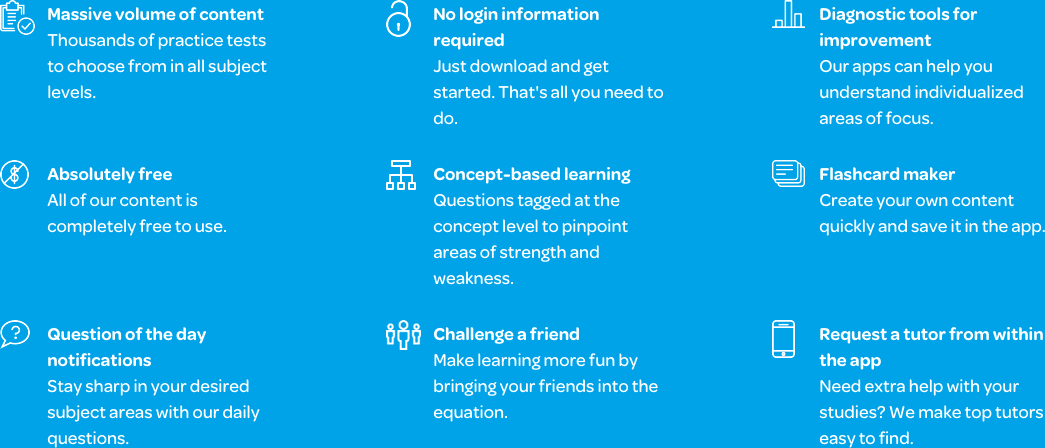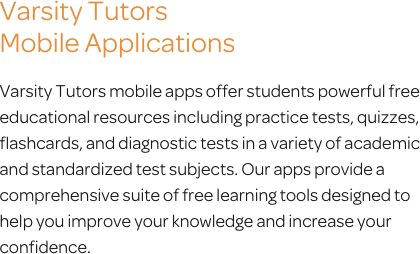The Varsity Tutors AP Physics C Mechanics Mobile App
The Varsity Tutors AP Physics C: Mechanics app is available on iTunes and the Google Play Store. Available for iOS and Android devices, this app includes various tools for practicing the advanced, calculus-based course content and preparing for the AP exam. The course is for students planning to major in physical science or engineering and potentially specialize in these fields as career paths. In your AP Physics C: Mechanics course, you’ll encounter topics such as Newton’s laws of motion, kinematics, and systems of particles and linear momentum. Work, energy, and power are core concepts in this physics course. You’ll also encounter circular motion and rotation, as well as oscillations and gravitation. As the main topics of the class, these will be a major part of your studies and the exam you will ultimately want master.
There are many areas to focus on when studying. Firstly, a background in calculus is essential, and you may even be taking this level of math concurrently with your physics course. In the course, you will design experiments, observe and measure physical phenomena, and analyze data. The laboratory work also involves analyzing any sources of error and an ability to determine the source of any uncertainties in measurements. You’ll also have to draw inferences from the observations made and data collected, as well as communicate the results of experiments. As an aspiring physics and mechanics expert, you will have the chance to suggest how experiments can be improved and propose new ones to study.
All the hard work culminates in the AP Physics C: Mechanics exam. This difficult test has a multiple choice section with 35 questions you’ll have 35 minutes to answer. These include discrete and grouped questions. A 45-minute free response section includes three questions that are laboratory-based and also discrete. Like many exams, this one requires sound knowledge and skills and familiarity with its format and structure. This is where the AP Physics C: Mechanics app comes in. It includes several tools to help you along.
Full-Length Practice Tests provide full coverage of the course content, enabling you to work through the material to identify what you know well and what your weaknesses are. These are questions similar to those that have been on the exam before. Whatever content you are less familiar with, therefore, should be the focus of your studies. They are also set up like the actual exam, allowing you to familiarize yourself with the format. Realistic assessments after you complete the exam identify your score, percentile, and speed. The explanations of the answers and concepts offered at the end can serve as study review materials.
Shorter practice tests focus on individual topic areas, as does the Learn by Concept interactive syllabus. Here, you’ll see series of questions, answers, and explanatory details on subjects such as electricity and magnetism, gravity, motion, and energy. You can also get quick reviews with flashcards, covering as much content as you see fit or have time for. These can even be customized with your own text, audio, or video on your smartphone. Another tool is the Question of the Day, where you can log in to see a question that’s selected from the pool of topics on the many practice tests available.
The tools available in the Varsity Tutors AP Physics C: Mechanics app, available for iPad, iPhone, and Android devices, provide comprehensive study materials to help you master the advanced content and mathematical demands of the course and exam.
66 mobile apps to choose from for your tutoring needs.

Learn More
Advanced Placement (AP) Physics C: Mechanics is the first of two college-level, calculus-based courses offered in the AP Physics program, which also features two college-level, algebra-based physics courses. AP Physics C: Mechanics focuses on six main areas of study, including Newton’s laws of motion; kinematics; work, energy, and power; circular motion and rotation; systems of particles and linear momentum, and gravitation and oscillations. This course is followed by AP Physics C: Electricity and Magnetism. Together, the two classes of the AP Physics C suite give students a strong start in calculus-based physics. A comprehensive set of study tools for this course is available to you on the go with the Varsity Tutors AP Physics C: Mechanics app for iPhone, iPad, and Android device.
Students will use introductory-level differential and integral calculus skills in this course, and should have already taken or be simultaneously enrolled in a calculus course. Twenty percent of the course time will be spent performing inquiry-based, hands-on laboratory experiments, increasing students’ knowledge of best scientific practices. This approach to learning the concepts of calculus-based physics provides opportunities for students to interact with the material in an engaging manner. Students are expected to build a portfolio of their lab notes, processes, records, and results. AP Physics C: Mechanics is particularly appropriate for students who are interested in majoring in engineering or physical science, and excelling on the exam can provide a variety of benefits to those who dedicate themselves to mastering the material.
AP Physics C: Mechanics requires students to continue building their skills in solid scientific practices. They will be required to competently design experiments and observe and measure real physical phenomena. Students will also learn methods that assist them in displaying, organizing, and critically analyzing data. They will determine uncertainties in terms of measurement and assess sources of error, and will develop advanced skills in drawing inferences from both data and observations. Finally, they will be expected to effectively communicate their findings, including ways that future experiments may be improved and new questions that may arise from the results of the experiment. All of these skills can be polished with the Varsity Tutors AP Physics C: Mechanics app, available for free download from iTunes and the Google Play Store.
There are six main learning objectives in AP Physics C: Mechanics, intended to give students a comprehensive introduction to calculus-based physics. The first is kinematics, and covers vectors, the components and algebra of vectors, displacement, coordinate systems, and acceleration. The kinematics unit will cover one-dimensional, two-dimensional, and projectile motion. In this unit, students will gain an understanding of the relationships among acceleration, position, and velocity of a particle moving along a straight line. Next, Newton’s first, second, and third laws of motion on static equilibrium, single-particle dynamics, and systems of two or more objects, respectively, are introduced. Students will learn to analyze the situations in which a particle will move with a constant velocity or remain at rest according to influential forces, the relationships between forces and changes in an object’s velocity, and identify force and object pairs. Then, concepts related to work, power, and energy are reviewed. This unit delves into the work-energy theorem, potential energy and forces, energy conservation, and power. Students should be confident in their understanding of the definition of work, the qualities of conservative force and potential energy, and analyzing, describing, and problem-solving within each of these topics.
The second half of AP Physics C: Mechanics begins with a deep dive into linear momentum and systems of particles. Students will be required to calculate, relate, and describe the center of mass, impulse and momentum, conservation of linear momentum, and collisions. In this unit, students will master the technique and application of linear momentum and center-of-mass velocity. Next, circular motion and rotation are discussed. The concepts involved in uniform circular motion, torque and rotational statics, rotational kinematics and dynamics, and angular momentum and conservation will be reviewed. Students will need to master a variety of calculations in this unit to determine the magnitude of centripetal acceleration, the direction of the torque of a given force, and the angular momentum vector for both moving and static objects. Finally, the course will cover gravitation and oscillations. This is the final unit of the course, so students will use all of the skills and concepts they have already learned to master the dynamics and energy relationships of simple harmonic motion, mass on a spring, Newton’s law of gravity, the orbits of planets and satellites, and pendulum oscillations.
The final exam, mimicked by free full-length practice tests in the Varsity Tutors AP Physics C: Mechanics app for iOS and Android devices, is 90 minutes in length, and is divided into two sections. Both sections are worth an equal amount toward the final score. The exam may ask students to demonstrate their proficiency in any of the topics covered over the semester-long course, and the questions will assess students’ experimental skills as well as their understanding of the content. Students will need to have gained a deep familiarity in order to succeed on this exam, as many of the questions will require them to synthesize information from a variety of areas. Section I is made up of 35 multiple-choice questions that must be answered within 45 minutes. There are both discrete questions and question sets within this section. Section II consists of three free-response questions that must be answered within 45 minutes. There are both discrete and laboratory-based questions in the free-response section. Students are allowed to use an approved graphing calculator throughout the entire exam.
AP Physics C: Mechanics is an intensive, upper-level calculus-based physics course that can demonstrate a student’s interest in and aptitude for the field of physics. Along with using a student’s AP Physics C: Mechanics Exam score to place them in a course of appropriate difficulty and award potential credits, colleges may also consider their score as a factor in admissions decisions. Students who are interested in majors like astronomy, chemistry, electrical engineering, or nuclear engineering will find AP Physics C: Mechanics a particularly useful course. Those who are interested in becoming actuaries, computer programmers, or meteorologists will be able to use the concepts and skills learned in AP Physics C: Mechanics to enhance their professional skillset. Through dedication and focus on the fundamentals, AP Physics C: Mechanics students have the opportunity to establish a foundation that can support them in their postsecondary studies and in their future professional endeavors. Get started working to ensure your success with the Varsity Tutors AP Physics C: Mechanics app, available from free download from iTunes and the Google Play Store today.




